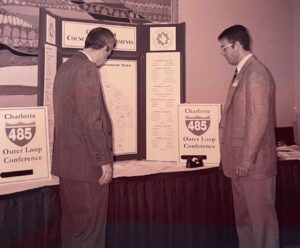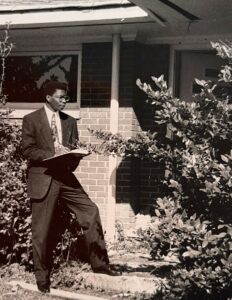This year marks the 55th anniversary of the founding of Centralina Regional Council, formerly known as Centralina Council of Governments. Over the last five and a half decades, our organization has helped support the growth and prosperity of our region through various projects and initiatives. In honor of this historic year, we’re looking back at how our organization has evolved to where it is today.
The Formation of Regional Councils
In 1968, Congress began working to pass the Intergovernmental Cooperation Act, which called for closer cooperation between federal programs and state and local governments. The passage of that legislation precipitated the 1969 North Carolina legislation designed to create a system of multi-county regional planning districts to cover the entire state. By this time, the idea of Centralina was already in the works. In 1967, representatives from 28 local governments within the greater Charlotte region gathered to discuss the importance of working together to achieve regional prosperity and by 1968, the outlines of Central Piedmont Regional Council (later changed to Centralina Council of Governments in 1972) were solidified. Our charter was signed on September 18, 1968, and in early 1969, Centralina’s first executive director, Charles Turner, was appointed.
The First Twenty Years
“In the initial formation period of the organization, Centralina focused on issues of regional significance as identified by member governments. Former chairman of the board, Milton Short, gave an address in 1972 that stated Centralina would expand its focus to address housing, transportation, parks and recreation and the environment. We coordinated with the NC Energy Institute and the Western Piedmont Council of Governments to create the Resource Recovery Feasibility Study to map paths for governments to reduce their solid waste while also generating energy. Centralina’s portfolio evolved to include responsibilities delegated to it from federal and state agencies, including administering aging services and older adult programs. Highlights from this period include:

-
- Used the US Housing and Urban Development (HUD) 701 program in 1970 to support planning assistance
- Established the regional aging ombudsman program
- Created the first Centralina Area Agency on Aging three-year plan for the Region F Aging Advisory Committee that worked to address nutrition, employment and other aging-related services
- Formed the Centralina Certified Development Corporation, offering small business loans and assistance
- Formed Centralina Workforce Development Board (WDB) under the name Centralina Private Industry Council, the first multi-county, regional board in the state
The 1990s

With the region growing rapidly by the 1990s, it was evident that local governments needed to focus on collaboration to coordinate on growth and economic development in response to the continued decline of the region’s textile industry. For example, in 1994, a steering committee convened to develop the 18-county Our Region Tomorrow strategic plan, which included a focus on recreation, infrastructure and the environment. A lesser-known aspect of Centralina’s history was our role in the emergence of the 911 system. When this emergency phone number was being rolled out, Centralina helped secure funds for EMS programs, offered training and education courses, helped set up information systems, coordinated risk management studies and facilitated cardiac equipment group purchasing for our region’s fire stations. Other highlights include:

-
- Assisted member governments with newly passed Americans with Disabilities Act compliance via training, facility inspections and suggested modifications of job descriptions and personnel practices
- Began offering code enforcement, building inspection and other technical assistance services to local governments
- Charted our region’s first JobLink Career Center (now NCWorks Career Center)
- Began testing and implementation of geographic information systems (GIS)
- Cohosted the I-485 forum to discuss the outer belt’s likely regional impacts and proposed development at its 36 interchanges
The Next Twenty Years

With the dawn of the twenty-first century, our region faced new challenges which required the organization to adapt and grow. Centralina saw new leadership with Executive Director Al Sharp stewarding the organization from 2002-2010. Centralina established what would become the Centralina Community Economic Development department and the human resources department. In 2010, Centralina brought on Jim Prosser as Executive Director who served until 2018. During this period, the CONNECT Our Future initiative kicked off with the goal of creating a framework for guiding and investing in the region’s growth, which still serves us today as the foundation for other regional collaboration projects such as CONNECT Beyond. Jim emphasized community engagement to ensure these plans reflected the people living throughout our region. He also saw that there was a strong desire for Centralina to play a larger role in helping communities coordinate their efforts to gain funding for growth.
A few other highlights from this time:
-
- In 2005, the elected officials of our region began developing the CONNECT Regional Vision that was adopted shortly afterwards in 2008
- Centralina Regional Planning completed the 14-county Greater Charlotte Regional Freight Mobility Plan
- Centralina Clean Fuels Coalition was officially designated in the US Department of Energy Clean Cities program
- Centralina established the Centralina Economic Development Commission, later changing to the Centralina Economic Development District
- Competitive Workforce Alliance formed to encourage regional cooperation among the Centralina, Charlotte-Mecklenburg and Gaston workforce development boards and the Charlotte Regional Partnership, later expanding to include South Carolina and four more workforce boards
- Centralina WDB launched the NC Manufacturing Institute in partnership with Rowan-Cabarrus Community College, Cabarrus Regional Chamber of Commerce, Cabarrus Economic Development, Rowan Chamber of Commerce and RowanWorks
The Next Chapter: 2019 to Present

Geraldine Gardner became the next Executive Director of Centralina in January of 2019. After fifty years of service to the region, Centralina rebranded to Centralina Regional Council. The new name, logo and website was an effort to increase the visibility and positioning of the organization in the region. Another key change was the creation of the Government Affairs & Member Engagement (GAME) department to focus on intergovernmental affairs, member engagement and support services. Our technical assistance work also tripled during her short tenure. “Our experts and departments do excellent award-winning work, so my focus has really been on three main areas: external relationships within and outside of the region, our long-term fiscal health and expanding our internal capacity to support a growing organization,” states Geraldine.
In 2020, we launched a multi-department effort to aid local governments, businesses and older adults during the COVID-19 pandemic response and recovery, including American Rescue Plan Act implementation. In 2021 we launched the Regional Resilience Collaborative to address disaster recovery planning needs. That same year, we also adopted the 12-county CONNECT Beyond regional mobility plan. Centralina is currently implementing our first three-year strategic plan, adopted in 2022, that sets the foundation for improving our fiscal health and building our organizational capacity.
In Closing
Centralina has seen a multitude of changes over the last 55 years. Executive directors have changed, and our organization has shifted our focus and service offerings to meet the shifting needs of our region. As we’ve grown and adapted over the decades, Centralina has remained dedicated to serving its communities and working to build a stronger, united region that can face the challenges of today and tomorrow. We look forward to continuing to lead regional collaboration and spark local action for 55 more years.
Photo Captions
- Former Chairman of the Board, Milton Short, giving an address in 1972 focused on Centralina expanding focus areas.
- Former Centralina Board Chair, James G. Martin, who later became Governor of North Carolina in 1985, speaking at a Centralina meeting.
- Attendees reviewing materials at the I-485 forum.
- Centralina Community Economic Development Administrator, James Luster, conducting code enforcement inspection work in the region.
- Anson County Commissioner & Centralina Board Secretary Jarvis Woodburn, former Wadesboro Mayor Bill Thacker and former Centralina Executive Director Al Sharp.
- Former Executive Director, Jim Prosser, talking with current Executive Director, Geraldine Gardner at Centralina’s 50th Anniversary Celebration & Region of Excellence Awards.





